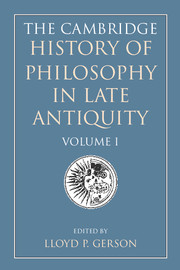Book contents
- Frontmatter
- General introduction
- I Philosophy in the later Roman Empire
- II The first encounter of Judaism and Christianity with ancient Greek philosophy
- Introduction to Part II
- 13 Philo of Alexandria
- 14 Justin Martyr
- 15 Clement of Alexandria
- 16 Origen
- III Plotinus and the new Platonism
- IV Philosophy in the age of Constantine
- V The second encounter of Christianity with ancient Greek philosophy
- Map 1 The Byzantine Empire, c. 500
13 - Philo of Alexandria
from II - The first encounter of Judaism and Christianity with ancient Greek philosophy
Published online by Cambridge University Press: 28 May 2011
- Frontmatter
- General introduction
- I Philosophy in the later Roman Empire
- II The first encounter of Judaism and Christianity with ancient Greek philosophy
- Introduction to Part II
- 13 Philo of Alexandria
- 14 Justin Martyr
- 15 Clement of Alexandria
- 16 Origen
- III Plotinus and the new Platonism
- IV Philosophy in the age of Constantine
- V The second encounter of Christianity with ancient Greek philosophy
- Map 1 The Byzantine Empire, c. 500
Summary
INTRODUCTION
With the appearance of John Dillon’s pioneering account of Middle Platonism (1977), a major shift occurred in the landscape of opinion that had earlier characterized the interpretation of Philo’s writings. Alternating emphases on either Platonism, Stoicism, eclecticism, mystery cults, or even Gnosticism, which had marked the various efforts to identify Philo’s primary extra-biblical sources of inspiration were finally eliminated by Dillon’s convincing demonstration that the context that best explains his philosophical formulations is that of Middle Platonism, an approach that was then further elaborated in remarkable detail by David Runia in his landmark work Philo and the Timaeus of Plato (1986). Indeed it was Runia who raised Philonic studies to a new level of intellectual excitement. It is hardly unexpected, however, with a thinker such as Philo, whose primary aim was to build bridges between Judaism and Hellenism, that scholarly opinion concerning the proper evaluation of that effort should remain significantly divergent. Thus, according to Runia, following in the footsteps of V. Nikiprowetzky (1977), as a biblical exegete, Philo saw it as his task to search for the ‘authentic philosophy’ embodied in the Mosaic record, inasmuch as the latter constitutes ‘the indispensable touchstone for determining what the highest philosophy actually is’. Virtually ignored in this assessment, however, is the unique character of Philo’s allegorical/midrashic exegesis, a mode of interpretation dominated by a very special agenda. ‘Midrash’, as P. Alexander has correctly observed, ‘is as much a means of imposing ideas upon Scripture as of deriving ideas from Scripture.’
Keywords
- Type
- Chapter
- Information
- The Cambridge History of Philosophy in Late Antiquity , pp. 235 - 257Publisher: Cambridge University PressPrint publication year: 2000
- 1
- Cited by

